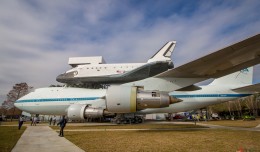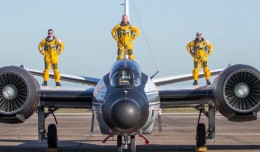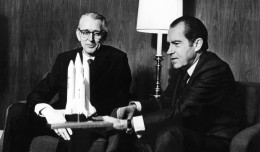44 years ago, a Boeing 747-123, construction number 20107, line number 86, registration N9668 was delivered to American Airlines to start its life. Four years later, it left the American Airlines fleet and was delivered to NASA with a new registration N905NA. For everyone at NASA, it became known as NASA 905 and for the last 30 years, it has been known at the Shuttle Carrier Aircraft (SCA) – that is, when the NASA Space Shuttles required transport from one part of the country to another, the shuttle would be coupled to the back of NASA 905 for the journey.
With the retirement of the Space Shuttle fleet, NASA 905 spent the last couple of years of its life transporting shuttles to their final resting places at museums around the United States. Finally it has come time that NASA 905 itself goes to its final retirement resting place just outside the front doors of the visitor center at NASA’s Johnson Space Center, where it will be the centerpiece of a new $12 million exhibit, complete with a mock-up of a space shuttle on its back.
Following the acquisition of the SCA in 1974 by NASA, engineers from Boeing carried out extensive modifications to the aircraft. The original first class seats were retained for NASA passengers, but the main cabin and insulation were removed. The mounting points for the shuttle were added, the overall fuselage strengthened and vertical stabilizers added to the tail structure to make the whole aircraft more stable when carrying a shuttle. The avionics and engines were also upgraded as well as additional instrumentation to monitor the electrical loads of the shuttle mounted on the aircraft. All the additional weight and drag of carrying a shuttle had severe impact on the operational performance of the SCA. Range of the aircraft was reduced from 5,500 nautical miles empty to 1,000 nautical miles loaded and the maximum operating ceiling of the SCA when carrying a shuttle was 15,000 feet. In 1983, the SCA was used to carry the first shuttle (Enterprise) on a tour of Europe. Because of the severely impacted range of the aircraft carrying the shuttle, stops were made in Canada, Iceland, England and West Germany before it was exhibited at the Paris Air Show.
In 1988 following the Challenger disaster, NASA purchased a second Boeing 747-100, this time a SR (short range) model from Japan Airlines. The second SCA was registered N911NA and it entered service with NASA in 1990. Its first operational flight was to transport the brand new shuttle Endeavour from Palmdale, CA where it was built to the Kennedy Space Center in Florida.

N905NA (right) shown nose-to-nose with with N911NA at Dryden Flight Research Center in November 1995. (Photo courtesy of NASA)
During their service with NASA, both SCA aircraft were based at the Dryden Flight Research Center at Edwards Air Force Base in California. NASA retired N911NA on February 8, 2012 following its final operational flight to Palmdale and has been used for parts in another NASA Boeing 747 project, the Stratospheric Observatory for Infrared Astronomy (SOFIA). On its retirement, N911NA had flown a total of 33,004 flight hours during its flying career including 386 flights as a NASA SCA which included 66 as ferry flights with a shuttle loaded on its back. N905NA’s last operational flight was the delivery of the shuttle Discovery to the Udvar-Hazy Center of the Smithsonian Air and Space Museum near Washington, D.C. Upon its retirement, it had flown a total of 11,018 flight hours both as a commercial aircraft and a NASA SCA. It flew 70 of the 87 ferry flights during the operational phase of the shuttle program which included 46 or the 54 post-mission ferry flights from Dryden to the Kennedy Space Center.
However, moving a Boeing 747–especially this one–is not as simple as people may think as it is currently parked in a remote area of Houston’s Ellington Field, nearly 8 miles from its final destination. How does one move a 232-foot long, 63-foot tall, 196-foot wingspan jumbo jet only 8 miles? The answer is to dismantle it. As part of its $4.5 million donation to the Shuttle and 747 Carrier Project, Boeing dispatched a team to Ellington Field on Feb. 17, 2014 to begin the 38-day project of dismantling of the aircraft. The team will remove the wings from the aircraft and then separate the aft fuselage from the rest of the body at two seam lines. With other smaller parts that have been removed, the nine large separated sections of the aircraft will be placed on transporters that will move through a designated path on Texas State Highway 3 and NASA Parkway in the Clear Lake section of Houston on the nights of April 28 and 29 to arrive at the Space Center on the morning of April 30. Workers will be dismantling and reinstalling street lights, signs and utility poles during the move of the convoy down the public roads. In much the same way as the Space Shuttle Endeavour was transported through the streets of Los Angeles, the movement of NASA 905 is expected to draw huge crowds that will follow the route in a convoy of 1,000 feet long.
Once all the sections arrive at Space Center Houston, all the removed parts will again be matched together on the recently poured concrete foundation of the outdoor exhibit, after which the space shuttle mock-up, named Independence, will be added to make up the six story attraction to open in 2015. The shuttle mock-up is currently finalizing restoration and interior upgrade to look very similar to the real shuttles at their retirement. It will also be the only shuttle exhibit that the public will be able to walk through.







